About Nam-gu
Cultural Heritages
HOME > About Nam-gu > History > Cultural Heritages
Gray Whale Migration Site
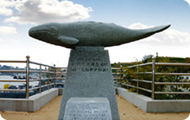
The Gray Whale Migration Site is a path through which gray whales migrate south to breed. The gray whales are also called ghost whales and are in danger of extinction due to whale hunting. Today, the gray whales in this area (western part of the North Pacific and North Atlantic) are in danger of extinction. However, thanks to protective efforts, the gray whales in the eastern part of the North Pacific are no longer in danger of extinction. Since the gray whale is an aquatic mammal vulnerable to extinction, the neighboring sea areas of Ulsan (in the East Sea) are designated and protected as a natural monument.
- Designation | Natural Monument 126
- Location | Coast of Ulsan in the East Sea
Shell Mound in Seongam-dong
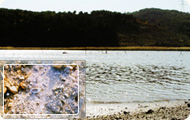
The shell mound is a historic site made from a pile of shell waste dumped by prehistoric people who lived on the shore and the river. Thanks to the calcareous property of shells, earthenware, stoneware, and animal bones have been well preserved in the mound, making it valuable archaeological research material. The shell mound in Seongam-dong is situated where the Oehwanggang River and the sea water join together. On southeast of the site, the Sejuk Relic Site in Ulsan, which is from the same period of the Shell Mound in Seongam-dong, is located, while in the northeast, the Gaeunposeong Fortress Site, which was the naval force camp of the Joseon Dynasty, is located. The shell mound was established through accumulation of gravel and earth deposited after the silt-type fine soil was pushed into the shore due to the difference in tides, and then eroded at the hill.
- Designation | Ulsan Metropolitan City Monument No. 25
- Location | The area of 451-4, Seongam-dong, Nam-gu, Ulsan
Gaeunposeong Fortress Site
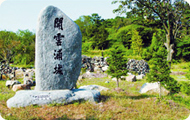
Designated as Ulsan Metropolitan City Monument No. 6 on October 9, 1997, the Gaeunposeong Fortress Site was originally a strategic location to defend against the Japanese during the Silla Period. It had an important role as a defense base against the Japanese for some 130 years from the period of King Sejo when the naval force camp (sugunmanho) was established in Gaeunpo in the early Joseon period, and then became affiliated with the provincial navy commander camp of the Gyeongsang jwado, until it was relocated to Dongrae during the reign of King Seonjo. In the late Joseon period, there was a shipyard to make combat ships, which were the largest armored ships among the military ships of the naval forces during the late Joseon Dynasty. The remaining site of the fortress was built measuring an area of 21,899㎡ with a circumference of about 1.28km during the early Joseon period. Traces of a moat, which girded the fortress, and the North and East Gate remain. The construction style of the fortress well illustrates the characteristics of the early Joseon period. In particular, the unique construction technique of erecting a huge stone on top of a stylobate is considered invaluable academic material for the study of fortresses in Korea.
- Designation | Ulsan Metropolitan City Monument No. 6
- Location | The area of 423, Seongam-dong, Nam-gu, Ulsan
Yihyujeong Pavilion
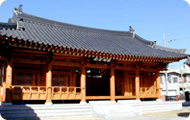
Yihyujeong Pavilion was built by Yi Dong-yeong of the Hakseong Yi Clan in 1662 (the 3rd year of the reign of King Hyeonjong). It was originally called ‘Yimijeong’ and changed to ‘Yihyujeong’ in 1666. The current building was used as Nammunru Pavilion of Hakseonggwan, which was the guest building of the Ulsan Dohobu (government office) in the past, however, in 1940 it was demolished and relocated to Sinjeong-dong and then rebuilt as a wooden house with a hip-and-gable roof by the Yi Family.
- Designation | Ulsan Metropolitan City Cultural Heritage Material No. 1
- Location | 20, Yihyujeong-gil, Nam-gu, Ulsan
Clothing Excavated from Tomb of Yi Cheongi and his family originated in Hakseong
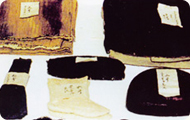
These clothes were excavated in 1969 from the graves of Yi Cheon-gi (1610-1666) and his wife (Heungryeo Park Clan) as well as from the graves of his third son Yi Ji-yeong and his wife (Pyeonghae Hwang Clan).
- Designation | Important Folklore Cultural Heritage 37
- Location | 277, Duwang-ro, Nam-gu, Ulsan (Ulsan Museum)
Cheoyongam Rock
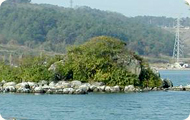
Designated as Ulsan Metropolitan City Monument No. 4 on October 9, 1997, Cheoyongam Rock is situated in Hwangseong-dong, Nam-gu, Ulsan. According to legend, one day, King Heongang of Silla (r. 875~886) visited Gaeunpo Lake to take a leisurely rest, when suddenly a deep fog made it difficult to see things. Ilgwan, the official in charge of divination and astrology, said that this was caused by a sea dragon, so we should appease the dragon by doing something nice for it. Therefore, the king ordered the building of a temple for the dragon in the area. The temple is Manghaesa Temple located in Cheongnyang-myeon, Ulju-gun. Thus, the fog and clouds totally cleared, and the sun rose. That’s why the area was named ‘gaeunpo’ meaning the clouds cleared away. At that time, the king of the East Sea was quite pleased, and came up to the land and danced together with his seven sons. One of the sons, Cheoyong, followed the king to Gyeongju. He married a beautiful woman and took up a government position ‘geupgan,’ the ninth rank among the 17 official ranks in Silla, to serve the country. When Cheonyong came up from the sea first, he landed on a rock, which is called ‘Cheoyongam.’
- Designation | Ulsan Metropolitan City Monument No. 4
- Location | 668-1, Hwangseong-dong, Nam-gu, Ulsan

